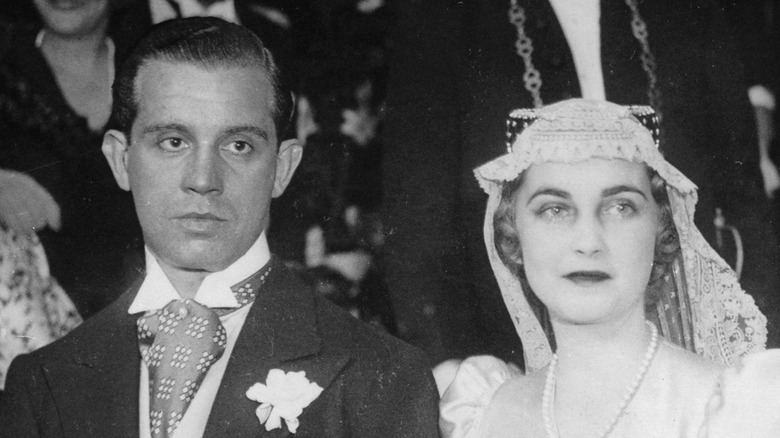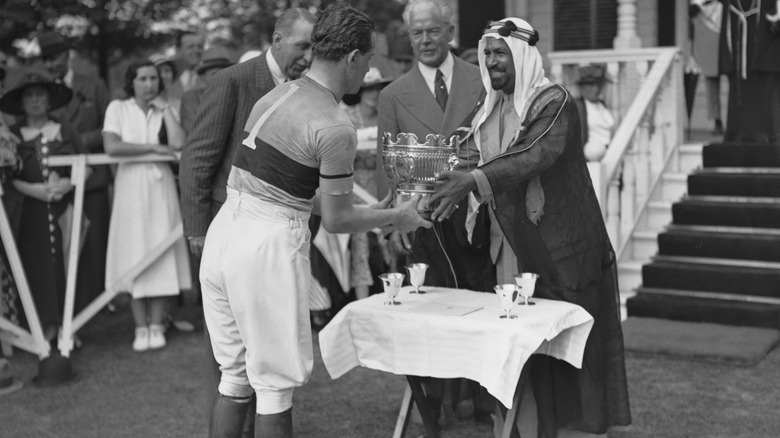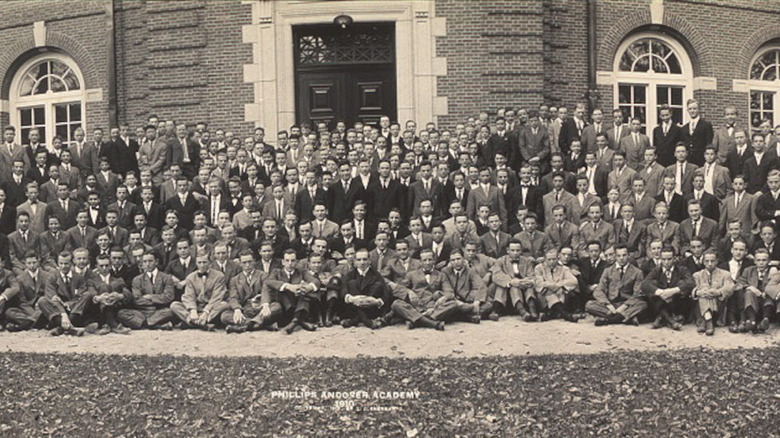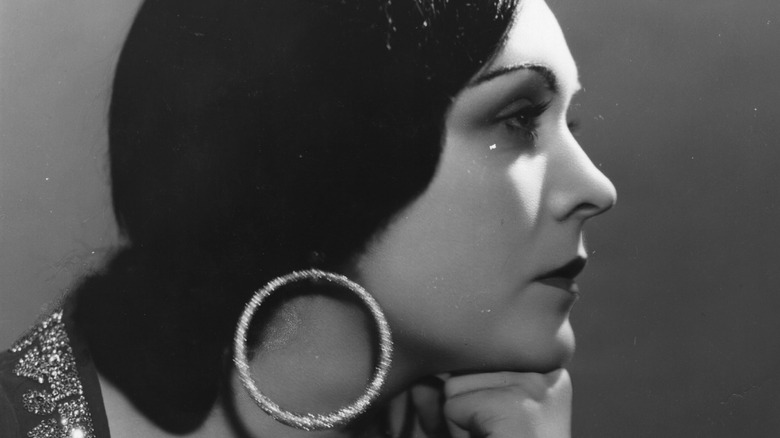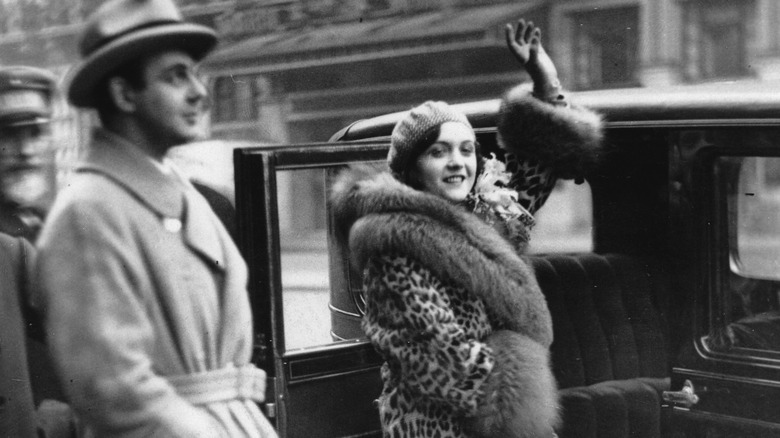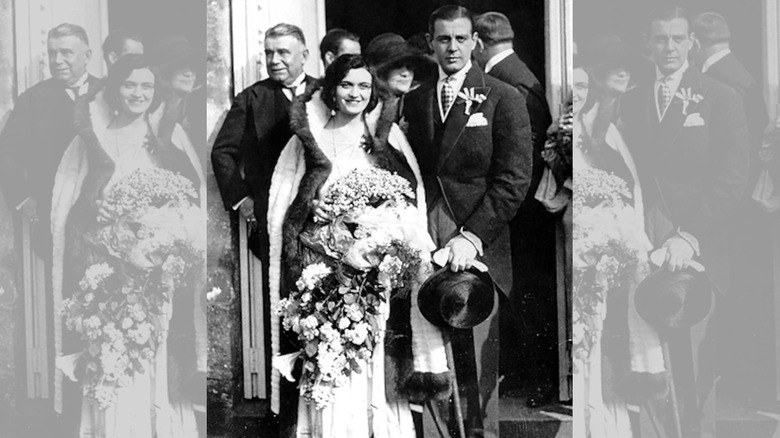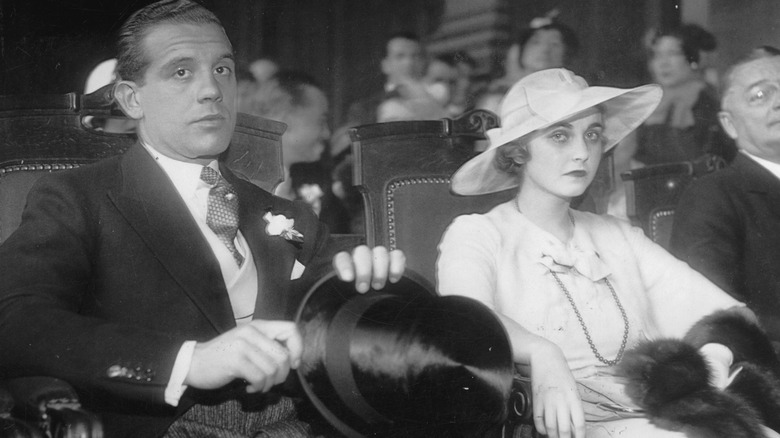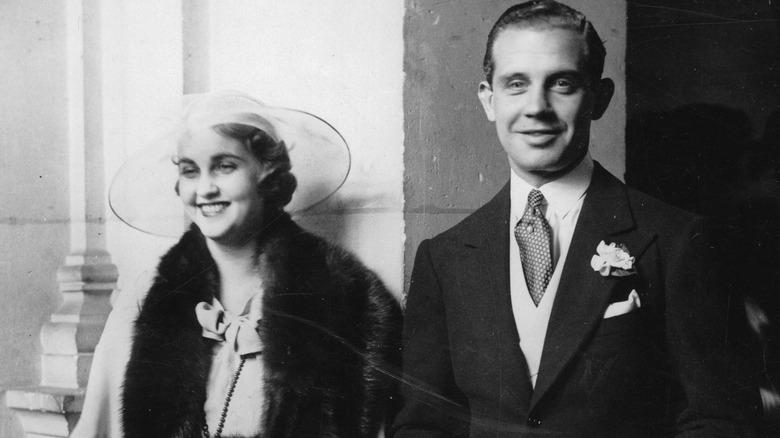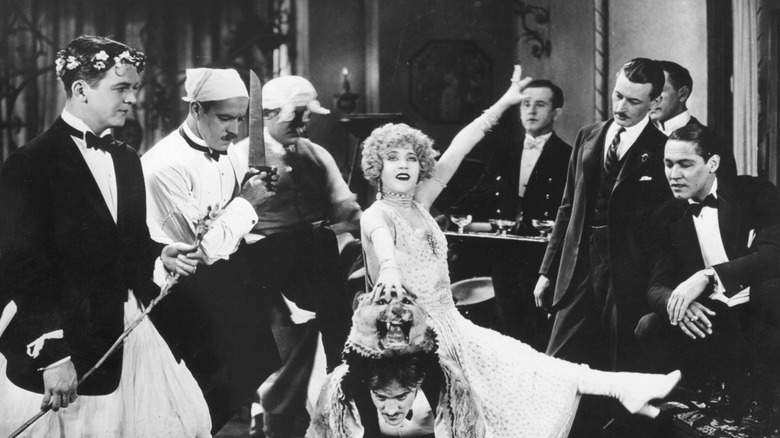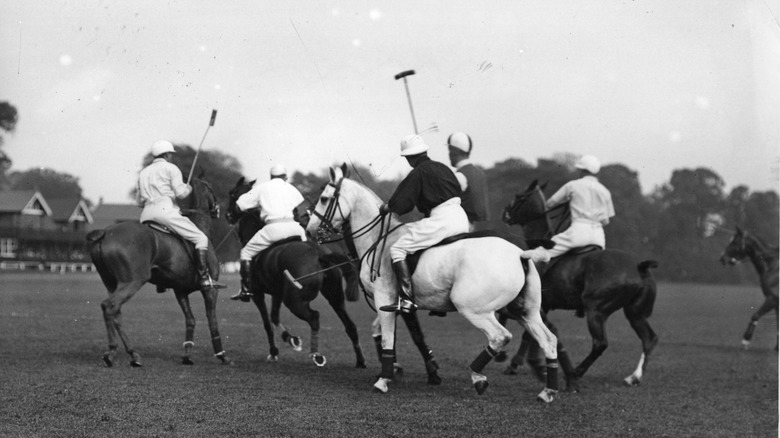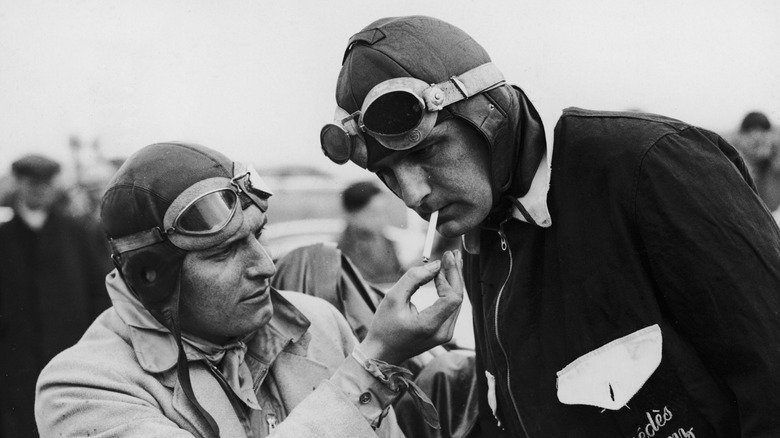The Marrying Mdivanis: How One 1920s Family Finagled Their Way To Fame And Fortune
We often think that the modern world is somehow wholly separate from the past, and that everything happening today is brand new. The fact is that human nature simply doesn't change that fast — technology does. Often what we experience in the modern world is really just an amplification of what's always been there, altered and evolved by new platforms, broader audiences, and new capabilities.
One area of life where this is very clear is fame. While we might think that the modern-day "famous for being famous," Kardashian-style fame is a product of the modern age and especially the rise of social media platforms, the fact is there have always been people skilled at living a certain kind of gossip-ready lifestyle, and there have always been families who were famous — and profited from that fame — solely because they were famous.
The Mdivani family is a prime example. Nearly a century ago, the five Mdivani siblings were collectively some of the most famous people in the world, impoverished, good-looking people who leveraged dubious royal titles into a spree of profitable marriages and headline-making scandals. They're not well-remembered at all today, but for a while, the "Marrying Mdivanis" were world-famous. Here's how they finagled their way to fame and fortune.
The Mdivanis claimed to be royal
As reported by Time, General Zakhari Mdivani and his family were part of a general exodus of aristocratic families out of Russia in the wake of the revolution that saw the Bolsheviks take power. Natives of Georgia, Mdivani had been recognized by the tsar and the Russian imperial court as a "prince," though this was a hollow title bestowed more or less on anyone who had "a pair of shoes, a stone house, a flock of sheep and a rifle."
When Zakhari arrived in Paris in 1923, he had no fortune, though according to Los Angeles Magazine, he claimed to have abandoned considerable oil wealth when he fled Georgia. What he did have were five good-looking, single children and something that a lot of people, especially Americans, wanted: That royal title, as dubious as it might be — according to Women's Wear Daily, their claim to nobility wasn't universally accepted, and certainly never conclusively proved. In fact, another Georgian claiming royal status, Prince Nicho las Dadiant, claimed that "mdivani" meant "secretary" in Georgian.
But whatever the truth, the Mdivanis knew that styling themselves as princes and princesses meant that they could give Hollywood movie stars and wealthy heiresses something that no amount of money could buy: A seemingly legitimate royal title that would require people to address them as a prince or princess.
A wealthy American gave them their start
No matter how good-looking or charming the Mdivanis were, they didn't have much to work with when they arrived in Paris, and they certainly had no easy way into American society. As noted by Los Angeles Magazine, that all changed when they met Marshall Crane, the wealthy heir to the Crane Stationery empire. Crane became very fond of two of the Mdivani children, David and Serge, and paid for them to travel to the United States and enroll in Phillips Academy prep school. The school, founded in 1778, has long been one of the most prestigious and exclusive schools in the country.
According to author Michael G. Ankerich in his book "Mae Murray: The Girl with the Bee-Stung Lips," Crane soon lost interest in supporting the Mdivani boys, and they briefly returned to Paris before going to New York. There the brothers "bummed around" while David tried to break into the movie business — without any success. They managed to get a letter of recommendation from a New York banker, and they traveled to Oklahoma to put their supposed family expertise in the oil business to work, signing on as roustabouts working in oil fields in Oklahoma.
They lasted a year before quitting, traveling out to Los Angeles, where they re-established their royal titles and set about finding an easier way through life that didn't require the filthy, sweaty work they'd been doing.
The Mdivanis were a hit in Hollywood
According to Los Angeles Magazine, when Serge and David Mdivani moved to Los Angeles, they didn't bother looking for business opportunities — they began hitting the social scene, using their good looks and princely titles as currency.
Author Sergio Delgado reports in his biography of 1920s actress Pola Negri (pictured) that her mother, Eleonora, came to Hollywood in 1925 and, lonely, began hosting lavish parties attended by many of the European actors and filmmakers who had come to California to work in the booming American movie business. David and Serge easily made their way to these gatherings, and they were soon the toast of the town.
In the 1920s, Hollywood actors were famous and well-paid, but they lacked social status — as noted by historian Kirsten Pullen in her book "Actresses and Wh****: On Stage and in Society," it wasn't that long since acting was looked down upon as a disreputable profession, often strongly associated with sex work. While Hollywood actors had largely moved past these old-school attitudes, they still weren't welcomed into high society. The Mdivani brothers, with their charm and old-world titles, offered a path to that kind of glamour to the royalty of the silver screen — and Hollywood offered the Mdivanis access to the one thing they really wanted: Money.
Two brothers married actresses
David and Serge Mdivani lost little time making the most of their access to Hollywood royalty. After meeting the wealthy actress Pola Negri at one of her mother's parties, Serge Mdivani made his intention to marry her obvious from the very beginning, according to author Sergio Delgado in his book "Pola Negri." He followed her to New York and stayed at the same hotel as she did, then booked tickets on the same boat to Europe as Negri in a transparent effort to convince her to marry him. Serge even sent a telegram announcing their engagement before even broaching the subject with her — and then wore her down with pressure tactics and charm.
According to Los Angeles Magazine, Serge's brother, David, was similarly aggressive when he met actress Mae Murray. Murray, who had once been known as "the Girl with the Bee-stung Lips," was 41 years old — 14 years older than David — and her career was fading. Finding her sleeping on a couch at a party, he leaned down and kissed her, telling her that in Georgia, that was just how things were done. Three weeks later, the two were married, and Murray was convinced to make David her manager. Women's Wear Daily reports that Mdivani convinced her to leave her studio, MGM — and as noted by author Michael G. Ankerich in his book "Mae Murray," this was disastrous — it prompted the powerful Louis B. Mayer to more or less end her career on the spot.
Serge Mdivani spent his wife's fortune
There's little doubt why Serge Mdivani pursued actress Pola Negri so aggressively: As reported by The New York Times, her personal fortune at the time was estimated to be about $5 million, which would be closer to $90 million in today's dollars. Serge's delight in becoming instantly rich was obvious before the couple even managed to have a honeymoon — Los Angeles Magazine reports that he was immediately such a fixture at a nearby casino after their wedding that Negri became used to being woken up by Serge presenting her with a kiss and promissory note to cover his losses.
Serge was a disaster for Negri. Author Sergio Delgado notes in his book "Pola Negri" that Mdivani was disruptive on film sets, complaining about love scenes Negri performed in and becoming enraged when people referred to him as "Mr. Negri." In order to placate him and give him something to do, Negri helped finance a real estate company for Serge to run. He quickly sank it into a quagmire of bad investments, and Negri was forced to shut it down before he ruined her completely.
In the end, however, Women's Wear Daily notes that ruination came thanks to the 1929 stock market crash, which wiped out Negri's fortune for good. Serge divorced the now-impoverished Negri and, within two years, had married again, to opera singer Mary McCormic.
All the Mdivanis married money
If David and Serge Mdivani proved to be first-rate gold-diggers in Hollywood, the siblings they'd left behind in Europe were almost as good at it, identifying rich targets and convincing them to get married with disturbing ease. As noted by Los Angeles Magazine, their younger brother Alexis began spending time with Jimmy Van Alen, a member of the fantastically rich Van Alen family, an offshoot of the Astors. Through that connection, Alexis met Jimmy's sister, Louise, just 18 years old at the time — and they were married just two years later, giving Alexis access to a world of money.
Meanwhile, Women's Wear Daily notes that the Mdivani sisters were equally busy securing their fortunes. Nina married Charles Huberich, a successful attorney with an international client list who also happened to be 24 years older than her. And Isabelle Roussadana — usually called Roussy — more or less ruthlessly targeted the much older and very, very married artist Josep Maria Sert. Roussy broke up his marriage with breathtaking determination and married him in 1928.
Bizarrely, according to author Mary McAuliffe in the book "When Paris Sizzled," Sert's now ex-wife Misia initially plotted to befriend Roussy in order to undermine her campaign of husband theft, but soon also fell a bit in love with Roussy, and accompanied the newlyweds on their honeymoon.
They were scammers
According to Los Angeles Magazine, the Mdivanis had always claimed they abandoned significant oil fields when they fled the Russian Revolution. Before coming to Hollywood, David and Serge Mdivani had even worked as roustabouts in oil fields in Oklahoma. So it wasn't entirely surprising when they acquired some oil leases in California and tried to get rich from them.
The scam started off legitimately: In 1930, Serge and David leased six lots in order to drill for oil and formed the Pacific Shore Oil company—funding the venture, according to author Christopher Wilson in his book "Dancing with the Devil," with their wives' money. They began selling shares in the company, raising about $200,000 using their new Hollywood connections and flashing their royal titles. In January 1931, one of their wells actually struck oil and began pumping black gold, making the company a success.
Or so it would seem. According to the New York Times, less than two years later, the brothers were under indictment on 14 counts of fraud and grand larceny. Specifically, they were accused of embezzling money from their own company while not paying their investors the royalties they were owed. According to the book "Mae Murray," the brothers were eventually removed from their positions in the company and wound up suing their own wives in court in an attempt to regain control.
Alexis Mdivani leveled up with a wealthier wife
According to author Jean Maddern Pitrone in the book "F.W. Woolworth and the American Five and Dime," by 1933, the Mdivani brothers had a worldwide reputation for "latching on to susceptible American heiresses or high-salaried motion pictured stars" in order to take control of their wealth. When Alexis Mdivani met the fabulously wealthy Barbara Hutton, heir to both the E.F. Hutton brokerage empire and the Woolworth chain of stores, he was still married to his first heiress, Louise Van Alen. But according to Los Angeles Magazine, Alexis openly pursued Hutton while vigorously spending his wife's money.
When Van Alen caught her husband and Hutton having an affair, she divorced Alexis—who immediately pivoted to proposing marriage to the even richer Hutton (she was so rich and so obviously lonely she was dubbed the "Poor Little Rich Girl" by the press). Barbara's father was alarmed and tried to delay the wedding, but Alexis and Barbara married in June 1933. Alexis reportedly received a "dowry" of $1 million from Hutton—which he spent very, very quickly.
Women's Wear Daily reports the shocking news that Alexis was a "terrible" husband. He drank and gambled constantly, and frequently insulted and ridiculed her, once complaining that she was too fat and prompting her to diet aggressively and lose 46 pounds.
There were a lot of messy divorces
You can't be a famous Hollywood family without a lot of drama, and the Mdivanis provided plenty of that. As their money-chasing marriages fell apart, there was a rash of divorces, followed by more marriages.
According to Los Angeles Magazine, Mae Murray filed for divorce from David Mdivani in 1931. She claimed that David had been abusive, beating her and chasing her with a loaded gun. Incredibly, he convinced her to take him back — but according to author Michael G. Ankerich in the book "Mae Murray" she filed again in 1933, once again noting his jealous rages and claiming he had stolen money from her. Not long afterward, opera Singer Mary McCormic filed for divorce from Serge Mdviani, making eerily similar claims of abuse and financial chicanery. And Barbara Hutton and Alexis Mdivani's marriage was a disaster, but by the Mdivani's gold-digging standards, it was their high-water mark: According to The New York Times, when Hutton and Mdivani divorced, Alexis received a settlement of over $2 million.
Nina Mdivani followed in her brothers' gold-digging ways, divorcing her first husband, attorney Charles Huberich when a better prospect came along: Denis Conan Doyle, son of Sherlock Holmes author Arthur Conan Doyle. It paid off: The marriage actually lasted until Doyle passed away, at which point Nina inherited his share of the Sherlock Holmes intellectual property.
Three of the siblings died tragically young
Stories of Old Hollywood glamour usually require some tragedy, and the Mdivanis, unfortunately, had that in spades. As the world slid into the Great Depression, things began to go wrong for the Marrying Mdivanis. Los Angeles Magazine reports that shortly after divorcing heiress Barbara Hutton and pocketing a huge settlement, Alexis Mdivani moved on to a new wealthy lover, Baroness Maud Von Thyssen. On August 1, 1935, Alexis was driving at high speed with Thyssen in a Rolls Royce when he crashed into a tree, killing him instantly. He was just 30 years old.
According to Women's Wear Daily, after divorcing opera singer Mary McCormic, Serge quickly moved on to a new source of money — Alexis's ex-wife, Louise Van Alen, marrying her in 1936. But then tragedy struck again: The New York Times reports that just a month later, Serge was killed in a bizarre Polo accident, kicked in the head by a horse.
Their sister, Isabelle, took the deaths hard. She became ill and frail, embarking on a cruise to get away from it all. But her health worsened, and she was finally diagnosed with tuberculosis in 1938. She was "tricked" into entering a sanitarium by none other than Coco Chanel, but it was too late — a little more than two years after Serge's death, Isabelle passed away at age 32.
David Mdivani got desperate
As noted by Los Angeles Magazine, by the 1940s, the sole surviving Mdivani brother, David, had lost any hint of his family's glamour. Desperate for money, he launched a series of dubious and largely unsuccessful lawsuits in an effort to claw money from his estranged former in-laws.
First, he sued his former sister-in-law, Louise Van Alen, claiming that she had swindled him in a deal trading shares in an oil company for a worthless tract of land. The suit was unsuccessful, but David had enough faith in the U.S. justice system to then turn around and sue his former brother-in-law Josep Maria Sert, claiming ownership of his sister's jewelry. This suit was also unsuccessful.
David continued to pursue wealthy women as a way to solve his financial crisis, and as noted by Women's Wear Daily, he succeeded in 1944 when he successfully courted Virginia Sinclair, heir to a huge oil fortune. As usual, the marriage started off well and quickly went sour. According to author Michael G. Ankerich in the book "Mae Murray," David and Virginia had a son together in 1945, and they were married for 15 years. But Virginia eventually sued for divorce in 1959, claiming "cruel and inhumane treatment." David's response was to sue a woman he believed to be his wife's lover, Virginia Catherwood, claiming she had "alienated the affections" of his wife. This worked — Virginia dropped the divorce. But they separated again in 1963, and finally divorced in 1964.
The last Mdivanis died lonely and broke
Despite all their efforts at acquiring wealth and status through marriage, the last living Mdivanis achieved neither. According to Los Angeles Magazine, Nina initially seemed to have landed best. When her second husband, Denis Conan Doyle, passed away in 1955, she inherited one-third of his estate — which meant she controlled one-third of the rights to Sherlock Holmes.
Women's Wear Daily reports that she married Denis' former secretary, Anthony Harwood, and moved aggressively to litigate her way to full control over the Holmes intellectual property. She and Harwood took out a large loan to buy out the rest of the family, but Nina did not manage the estate well. She spent every dime and failed to repay the loan, eventually losing control over Sherlock Holmes. According to the Los Angeles Times, she died in 1987, largely bedridden in her apartment.
David didn't fare much better. He attempted a second round of oil lease fraud in the 1960s, trying to convince wealthy friends to invest in a new company, without much success — even his sister Nina disdained him, saying he had "been placed in a position of helplessness." David's last play was to conceive of writing a tell-all memoir with his sister, but their declining health meant the memoir remained nothing more than talk. He died in 1984.
